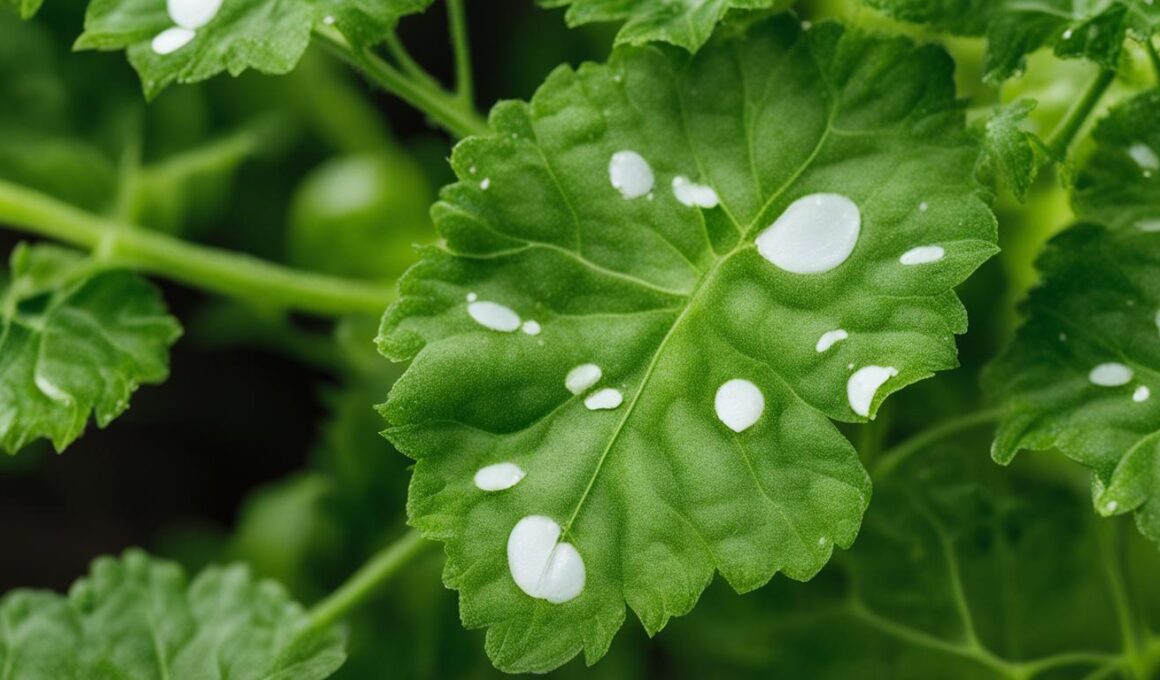Are you noticing white spots on your tomato leaves? Don’t worry, you’re not alone. Many tomato growers encounter this issue, and it’s essential to understand the causes and find effective solutions to keep your plants healthy and thriving.
There are several factors that can contribute to the development of white spots on tomato leaves. Fungal diseases like powdery mildew and late blight are common culprits. These diseases often appear as powdery white patches on the leaves, leading to discoloration and reduced plant vigor.
Pests can also be responsible for white spots. Insects like whiteflies and leaf miners can cause damage to the leaves, resulting in white spots or speckles. Additionally, mealybugs can leave behind a white, waxy residue that affects the overall health of the plant.
Environmental factors can play a role as well. Sun scald, which occurs when the leaves are exposed to intense sunlight, can lead to white spots. Salt build-up in the soil or water can cause similar symptoms, affecting the plant’s ability to absorb nutrients properly.
Nutritional deficiencies can manifest as white spots on tomato leaves. Imbalances in essential nutrients like calcium or magnesium can result in the appearance of white patches. Finally, viral infections, such as the tomato mosaic virus, can cause distinctive mottling and streaking on the leaves.
Identifying the specific cause of white spots on your tomato leaves is crucial in implementing appropriate treatments. It’s important to act promptly to prevent further damage to your plants and ensure a successful harvest. In the following sections, we will explore the causes of white spots in more detail and provide effective ways to treat and prevent this issue.
Stay tuned to learn more about the causes and fixes for white spots on tomato leaves.
Causes of White Spots on Tomato Leaves
There are several causes of white spots on tomato leaves that you need to be aware of. These can include fungal diseases, pests, and environmental factors. Let’s explore each of these causes in more detail:
Fungal diseases
One common cause of white spots on tomato leaves is fungal diseases. Powdery mildew and late blight are two fungal diseases that can result in the development of white spots. Powdery mildew appears as a white, powdery coating on the leaves, while late blight causes dark, water-soaked lesions that turn white as the disease progresses.
Pests
Pests can also contribute to the appearance of white spots on tomato leaves. Whiteflies, leaf miners, and mealybugs are common pests that can cause damage to tomato plants. These pests feed on the leaves, leaving behind white spots as they feed.
Environmental factors
Environmental factors can play a role in the development of white spots on tomato leaves. Sun scald is a condition that occurs when the leaves are exposed to intense sunlight, leading to the formation of white or yellow patches. Salt build-up in the soil can also cause white spots on the leaves.
Nutritional deficiencies
Nutritional deficiencies can manifest as white spots on tomato leaves. If the plants lack certain essential nutrients, such as calcium or magnesium, white spots may appear on the leaves. This is why it’s important to provide your plants with a balanced fertilizer to ensure they receive all the necessary nutrients.
Viral infections
Viral infections, such as tomato mosaic virus, can also cause white spots on tomato plants. This virus is easily transmitted and can lead to the development of mosaic-like patterns of white spots on the leaves.
It’s crucial to identify the specific cause of white spots on your tomato leaves in order to implement the appropriate treatment and prevent further damage to your plants. By taking the necessary steps to address the underlying cause, you can help ensure the health and productivity of your tomato plants.
How Do Aphids on Tomato Plants Lead to White Spots on the Leaves?
Aphid control on tomatoes is crucial to prevent white spots on the leaves. Aphids feed on the sap of tomato plants, causing them to become weak and develop white, yellow, or silver spots. Controlling aphids through natural predators, insecticidal soap, or neem oil can help prevent this issue.
Treating and Preventing White Spots on Tomato Leaves
When it comes to treating white spots on tomato leaves, it’s crucial to identify the specific cause first. Different causes require different treatments to effectively control and prevent further damage to your plants.
If the white spots are caused by fungal diseases, such as powdery mildew, it is recommended to remove the affected leaves and apply either a homemade or commercial fungicide. For late blight, another common fungal disease, removing the affected leaves and using a copper-based fungicide can help prevent its spread.
Pests like whiteflies, leaf miners, and mealybugs can also result in white spots on tomato leaves. To control these pests, you can use garden-safe pesticides specifically formulated to target these insects.
Other factors that can contribute to white spots include sun scald and salt build-up. You can prevent sun scald by providing shade or using windbreaks to shield your tomato plants from strong winds. Additionally, using rainwater rather than tap water and adjusting the strength of your fertilizer can help reduce salt build-up.
Nutritional deficiencies, such as imbalances in fertilizer or pH levels, can also lead to white spots on tomato leaves. Address these deficiencies by applying the appropriate fertilizer or correcting the pH value of the soil.
Lastly, viral infections like tomato mosaic virus may require disposing of infected plants to prevent further spread. Taking preventative measures, such as using a greenhouse, ensuring adequate airflow, removing yellow or brown leaves, and choosing disease-resistant tomato varieties, can greatly reduce the risk of white spots on your tomato leaves.
Remember, consistent watering, providing proper sunlight exposure, and appropriate fertilization are essential for maintaining the overall health of your tomato plants and minimizing the chances of white spots developing.









